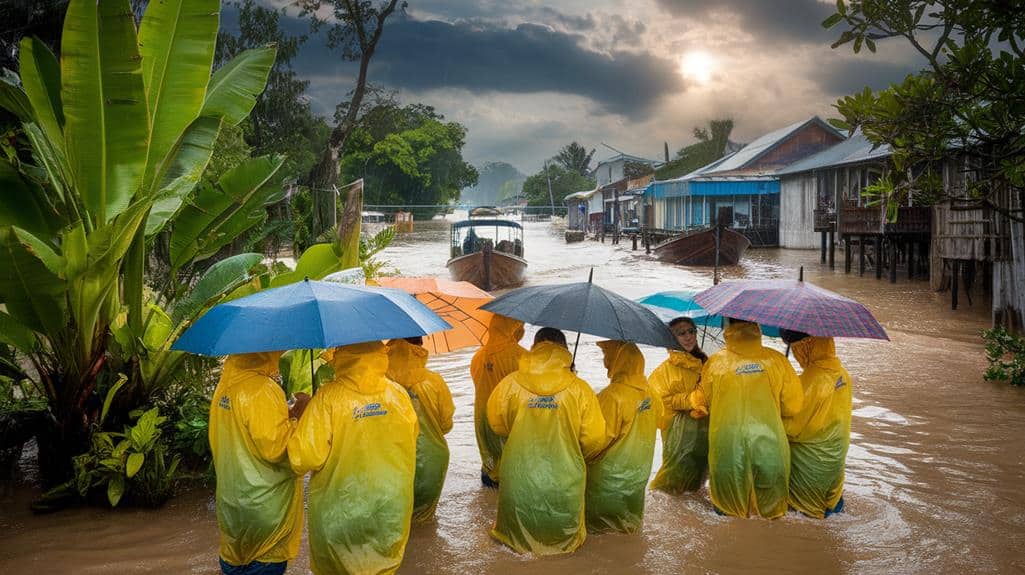
7 Smart Ways to Navigate Southeast Asia’s Monsoons
To navigate Southeast Asia's monsoons effectively, choose destinations wisely based on rainfall patterns and plan indoor activities for rainy days. Pack waterproof essentials, including rain gear and protective covers for electronics. Embrace flexible itineraries that allow for last-minute changes due to weather conditions. Utilize local transportation options, such as tuk-tuks or boats, which are often better equipped for monsoon conditions. Book accommodations strategically, opting for locations with easy access to amenities and transportation. Monitor weather forecasts daily to anticipate and adapt to changing conditions. By implementing these smart strategies, you'll be well-prepared to make the most of your Southeast Asian adventure, regardless of the weather challenges you may encounter.
In a Nutshell
- Regularly check reliable weather forecasts and monsoon updates for accurate trip planning.
- Pack appropriate waterproof gear and clothing to stay dry and comfortable during heavy rains.
- Maintain flexibility in your itinerary to adapt to changing weather conditions and potential travel disruptions.
- Choose accommodation in safe, elevated areas to minimize risks associated with flooding.
- Prioritize indoor activities and explore alternative transportation options during periods of intense rainfall.
Choose Destinations Wisely
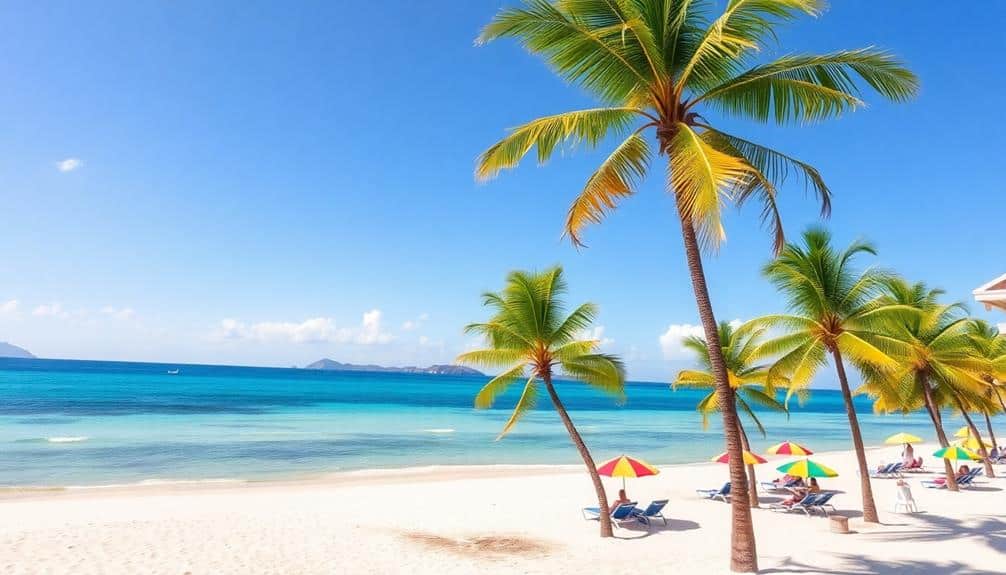
When planning your Southeast Asian adventure during monsoon season, choosing the right destinations is crucial. Consider areas with microclimates that experience less rainfall, such as Koh Samui in Thailand or Bali's eastern coast. These regions often remain drier while other parts of the country are inundated. Research historical weather patterns for your intended travel dates, focusing on average rainfall and number of rainy days per month. Coastal areas may offer more predictable weather, with afternoon showers followed by clear evenings. Inland destinations, particularly those at higher elevations, can experience prolonged periods of rain and potential flooding. If you're set on visiting a specific location, plan your itinerary around indoor activities and nearby alternatives for days when outdoor excursions aren't feasible. Don't forget to pack a portable cooler to keep your refreshments cold during your travels, especially if you're planning beach outings or outdoor activities between rain showers. Look for models with good insulation and waterproof designs to protect your belongings from unexpected downpours. By carefully selecting your destinations and having flexible backup plans, you'll maximize your enjoyment despite the monsoon season's challenges.
Pack Waterproof Essentials
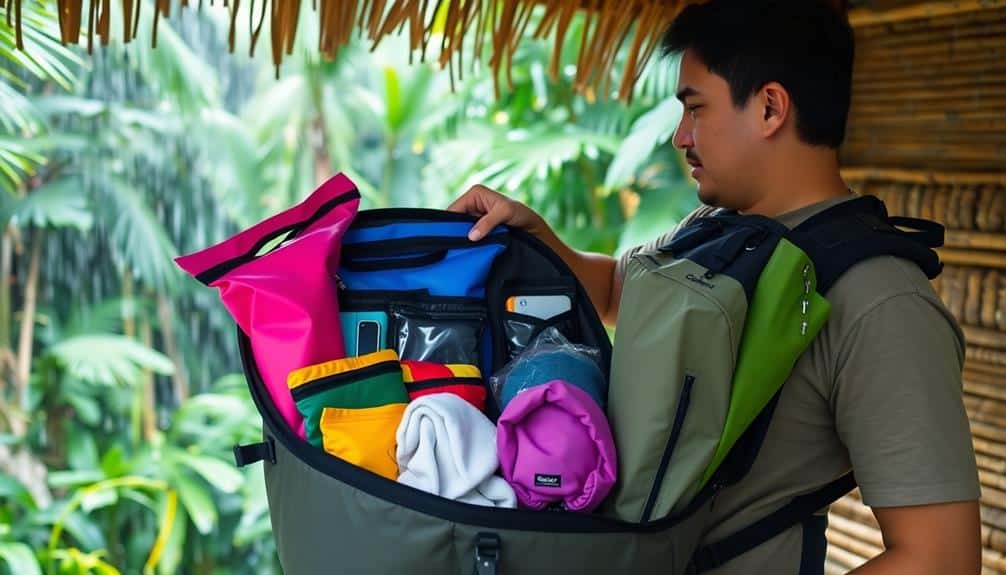
In light of Southeast Asia's monsoon season, packing waterproof essentials is crucial for a comfortable trip. Start with a high-quality, breathable rain jacket featuring taped seams and a water-resistant rating of at least 10,000mm. Opt for quick-drying, moisture-wicking base layers made from synthetic materials or merino wool. Include waterproof footwear, such as rubber boots or water-resistant hiking shoes with Gore-Tex lining. Don't forget a sturdy, collapsible umbrella with a wind-resistant frame and a minimum 40-inch canopy. For protecting your belongings, invest in a waterproof backpack or dry bag with a roll-top closure and sealed seams. Look for options with IP68 certification for complete submersion protection or those featuring multiple waterproof layers and welded seams. Pack resealable plastic bags in various sizes to safeguard electronics, documents, and other moisture-sensitive items. Consider bringing a lightweight, packable rain poncho as a backup option. These carefully selected items will guarantee you're well-prepared for Southeast Asia's unpredictable monsoon weather.
Plan Indoor Activities
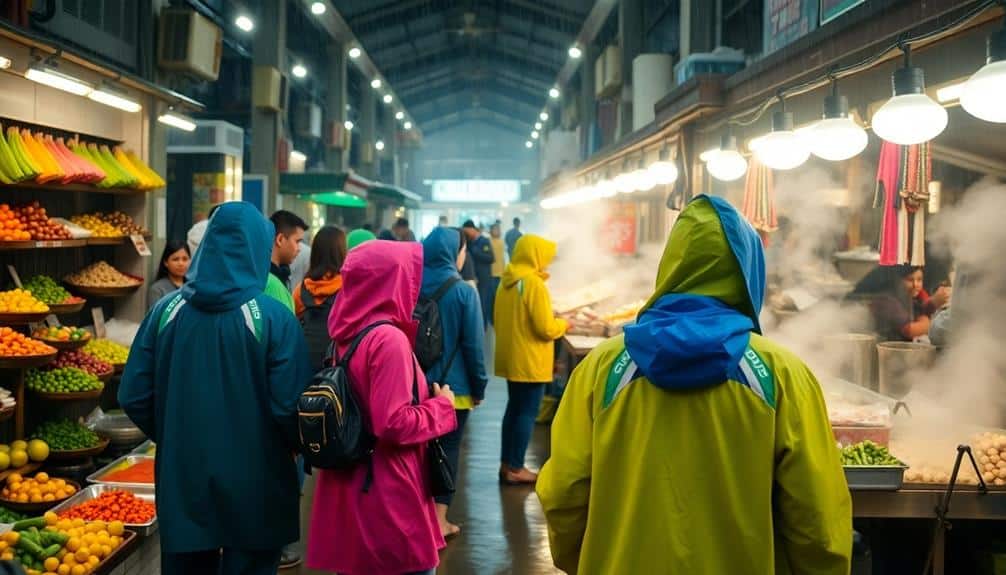
Given the unpredictable nature of monsoon weather, planning indoor activities is essential for an enjoyable Southeast Asian trip. Consider exploring the region's numerous museums, which offer insights into local history and culture. Many cities boast impressive art galleries, showcasing both traditional and contemporary works. To enhance your experience, consult insider travel tips from local experts and travel influencers for hidden gems and unique perspectives. You'll find indoor markets, like Bangkok's Chatuchak Weekend Market, where you can shop and sample local cuisine while staying dry. Luxury malls in Singapore and Kuala Lumpur provide air-conditioned retail therapy and dining options. For a unique experience, visit indoor theme parks like DreamWorld in Bangkok or KidZania in Jakarta. Cooking classes, often held in sheltered locations, offer a chance to learn about local cuisines. Don't forget to research local spas and wellness centers, which provide relaxing treatments perfect for rainy days. Always check opening hours and book in advance when possible.
Embrace Flexible Itineraries
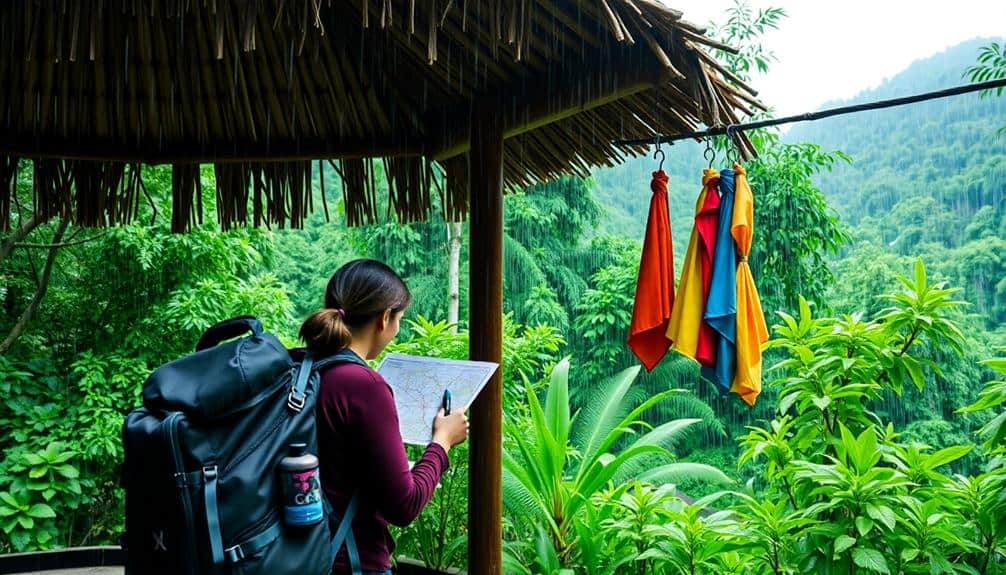
Embracing flexible itineraries is crucial when maneuvering Southeast Asia's monsoon seasons. Be prepared to adjust your plans on short notice, as weather conditions can change rapidly. Keep an eye on local forecasts and be ready to swap outdoor activities for indoor alternatives when necessary. Consider booking accommodations and transportation with flexible cancellation policies, allowing you to modify your schedule without incurring hefty fees. When planning day trips or excursions, have backup options in mind for each location. If rain disrupts your primary plans, you'll be able to seamlessly transition to alternative activities. Utilize travel apps and local resources to stay informed about current conditions and potential disruptions. By maintaining a adaptable approach, you'll maximize your enjoyment of Southeast Asia's diverse offerings, regardless of the weather. Remember, flexibility is key to successfully navigating monsoon seasons.
Utilize Local Transportation Options
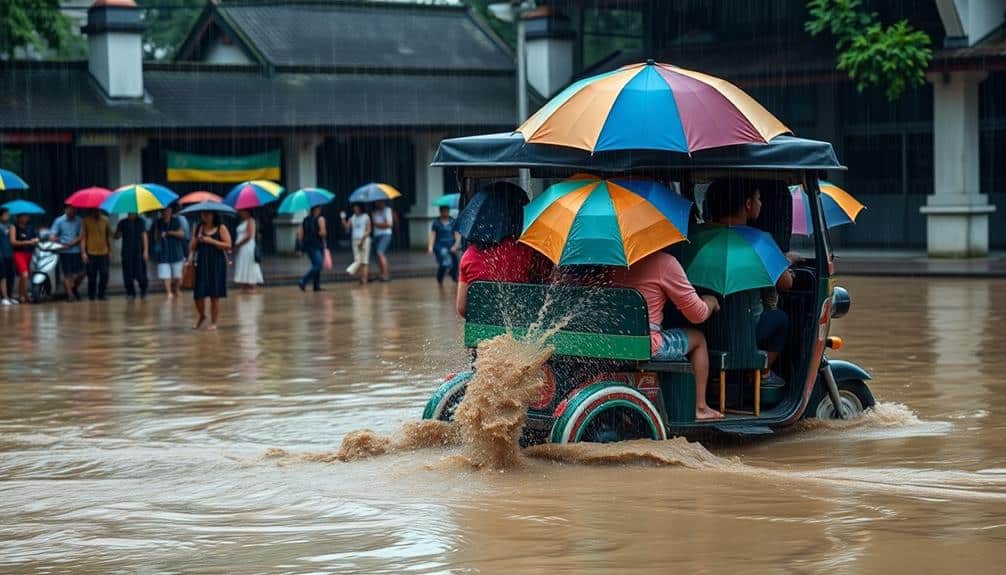
While traversing Southeast Asia during monsoon season, you'll find local transportation options invaluable. Tuk-tuks, motorbike taxis, and songthaews offer flexibility and convenience, allowing you to navigate flooded streets and unpredictable weather patterns with ease. These vehicles, often equipped with weather-resistant covers, provide protection from sudden downpours and are adept at maneuvering through congested urban areas.
For longer journeys, consider utilizing the region's extensive bus and train networks. Many of these services feature air conditioning and comfortable seating, making them ideal for extended travel during humid monsoon conditions. Ferries and water taxis, particularly in coastal areas and river cities, can be efficient alternatives when roads become impassable. When selecting transportation options, prioritize safety and reliability. Research reputable companies, check schedules for potential weather-related delays, and always have a backup plan in case of unexpected route closures or service interruptions.
Book Accommodations Strategically
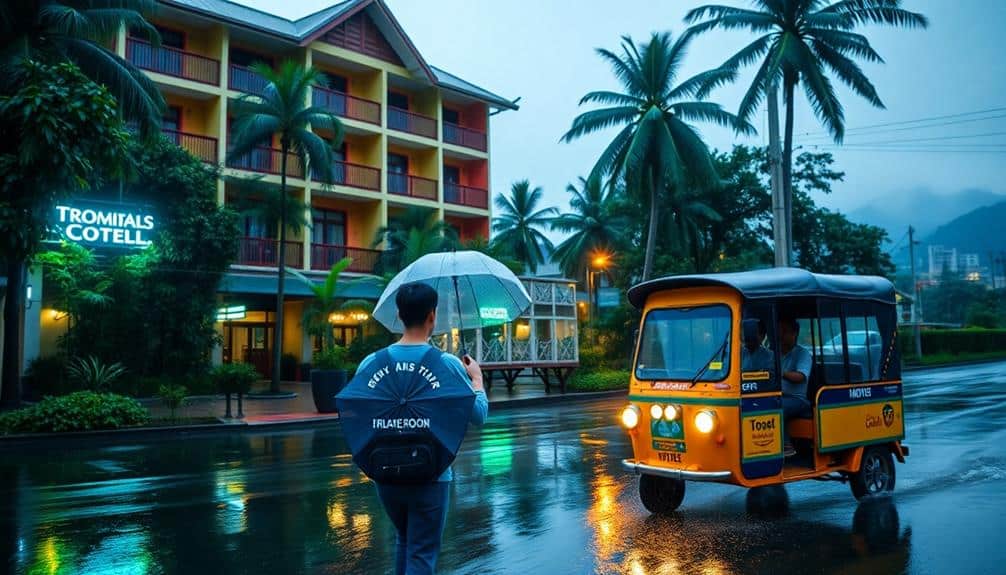
Selecting the right accommodations can make or break your Southeast Asian monsoon adventure. Opt for hotels or guesthouses with sturdy construction, elevated floors, and reliable backup generators. Look for properties with on-site restaurants, as venturing out during heavy rains may be challenging. When booking, inquire about the establishment's monsoon preparedness, including flood prevention measures and emergency protocols. Consider locations on higher ground or in areas less prone to flooding. If you're planning to stay in coastal regions, choose accommodations set back from the shoreline to minimize storm surge risks. Many hotels offer monsoon season discounts, so compare prices and amenities carefully. Don't forget to check cancellation policies, as weather-related disruptions may necessitate last-minute changes. By strategically selecting your accommodations, you'll guarantee a more comfortable and secure stay during Southeast Asia's unpredictable monsoon season.
Monitor Weather Forecasts Daily
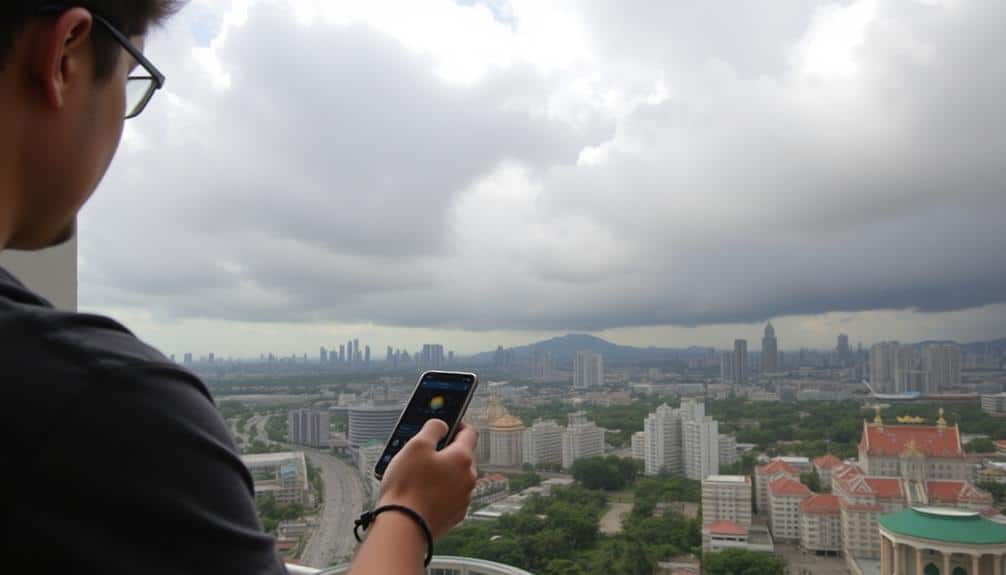
Your smartphone becomes an indispensable tool when traversing Southeast Asia's monsoons. Download reliable weather apps like AccuWeather or Dark Sky, which provide hourly forecasts and severe weather alerts. Check these apps multiple times daily, as monsoon conditions can change rapidly. Pay close attention to rainfall predictions, wind speeds, and potential flooding risks in your area. Many local meteorological departments also offer region-specific apps or websites with detailed monsoon forecasts. Enable push notifications for real-time updates on approaching storms or sudden weather shifts. Familiarize yourself with local weather patterns and seasonal trends to better interpret forecasts. Cross-reference multiple sources for a more exhaustive understanding of the weather situation. By consistently monitoring forecasts, you'll be better prepared to adjust your plans, avoid dangerous areas, and make informed decisions about outdoor activities or transportation options during your Southeast Asian travels.
Frequently Asked Questions
How Long Does the Monsoon Season Typically Last in Southeast Asia?
As the clouds gather like a heavy curtain, you'll find Southeast Asia's monsoon season typically lasts 3-6 months. It varies by region, with some areas experiencing longer periods. In Vietnam, for instance, the monsoon can stretch from May to November. Thailand sees it from July to October in most parts. Indonesia's monsoon generally runs from November to March. You'll need to plan carefully, as the timing and intensity can fluctuate yearly due to climate patterns.
Are There Health Risks Associated With Traveling During Monsoon Season?
Yes, there are health risks associated with traveling during monsoon season. You'll face increased chances of waterborne diseases, such as dengue fever, malaria, and cholera, due to standing water and flooding. Respiratory infections may also be more common. You're at higher risk of accidents from slippery roads and flooding. It's essential to take precautions: use insect repellent, drink bottled water, and stay informed about weather conditions. Consider travel insurance that covers medical emergencies and potential evacuation.
What's the Best Time of Day to Explore During Monsoon Season?
During monsoon season, you'll find the best time to explore is typically early morning, between 6 AM and 10 AM. This window often offers clearer skies and lower humidity before the day's rainfall begins. You'll also encounter fewer crowds at popular attractions. Alternatively, late afternoon, around 4 PM to 6 PM, can be suitable as storms may have passed. Always check local weather forecasts and be prepared with appropriate gear, regardless of your chosen exploration time.
How Do Monsoons Affect Flight Schedules and Transportation in Southeast Asia?
When the heavens open up, you'll find Southeast Asia's transportation landscape transformed. Monsoons can wreak havoc on flight schedules, causing delays and cancellations due to reduced visibility and strong winds. You'll need to brace for potential disruptions to ground transportation as well, with flooded roads impeding travel. It's essential to stay informed about weather forecasts and maintain flexibility in your plans. Consider booking with airlines that offer generous rebooking policies during monsoon season to alleviate potential inconveniences.
Are There Any Southeast Asian Festivals That Coincide With Monsoon Season?
Yes, several Southeast Asian festivals coincide with monsoon season. You'll find the Boun Bang Fai Rocket Festival in Laos, typically held in May or June, celebrating the start of the rainy season. In Thailand, the Phi Ta Khon Ghost Festival occurs in June or July, featuring colorful masks and parades. Cambodia's Water Festival, Bon Om Touk, takes place in November, marking the end of the monsoon. These events offer unique cultural experiences, blending traditional rituals with seasonal celebrations.
